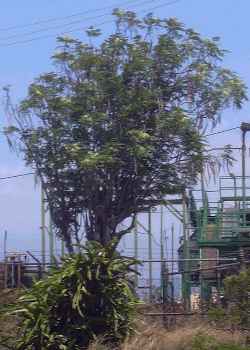Horseradish Tree
Scientific Name: Moringa oleifera Lam.
Synonym: Moringa pterygosperma
Family: Moringaceae

Moringa oleifera, habit, photo by Forest & Kim Starr, starr-030523-0125
Sunset®: 25
USDA: 9b-12
Frost Tolerance: Mature trees tolerate light frosts
Sun Exposure: Full sun to part shade
Origin: India, Arabia, and possibly Africa and the East Indies
Growth Habits: Deciduous to evergreen tree, very fast growing to 15 to 40 feet tall (5-10 m); umbrella shaped with drooping branches; tuberous tap root; corky whitish bark; pale green, feathery, compound leaves, 1 to 2 feet long (30-60 cm). tripinnate, elliptic to obovate leaflets, 0.5 to 0.8 inch long (1.3–2 cm), 0.12 to 0.25 inch wide (3-6 mm)
Watering Needs: Moderate to little water, drought resistant
Propagation: Seeds or cuttings
The name "horseradish tree" comes from the use of the roots.
Blooming Habits:
Fragrant, white or creamy-white flowers, 1 inch in diameter (2.5 cm), in drooping panicles.
Fruiting Habits:
Brown, triangular, pendulous, pods, 3-angled, 1 foot long (30 cm), 0.75 inch wide (18 mm), with many 3-angled brown seeds, with 3 papery wings.
Desert-Tropicals is dedicated to provide gardening advice, gardening ideas, and information about flower of all kind for landscape and collections.We try to check carefully the identification of the plants on the illustrations as well as the other information from the page, but occasionally errors do occur. if you notice anything that needs to be changed please contact us.Thanks.
© 1998-2020 Philippe Faucon, All Rights Reserved.